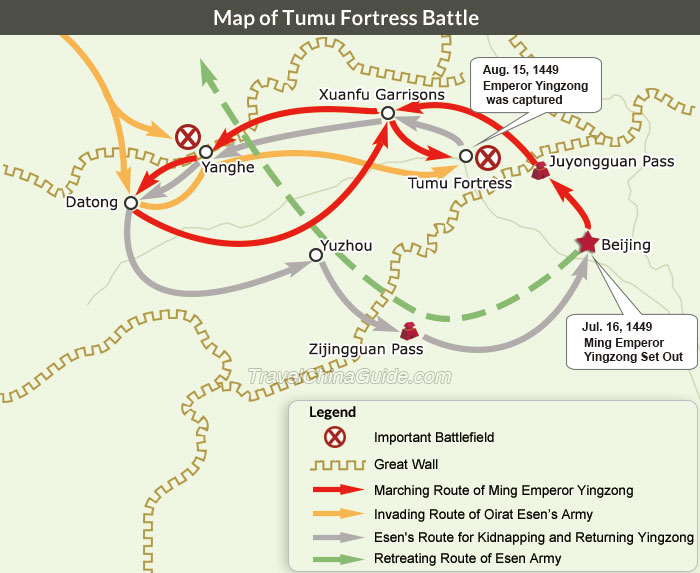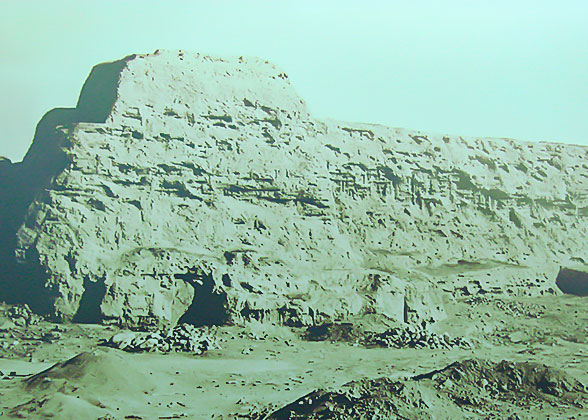Tumu Crisis
Basic Facts of Tumu Crisis
| Date | 1449 | |
|---|---|---|
| Location | Great Wall Tumu Fortress, Huailai County, Zhangjiakou, Hebei | |
| Belligerents | Han Chinese Ming Court (1368 - 1644) | Mongol Oirats |
| Military Force | about 220,000 | about 50,000-60,000 |
| Commanders | Emperor Yingzong, Eunuch official Wang Zhen | Oirat Taishi Esen |
| Casualties and Losses | about 1/2 injured and 1/3 died | Unknown |
| Result | The Mongol Oirats won and the Ming emperor got captured | |
The Oirats Invaded the Northern Frontier of Ming Court
In February of 1449, the actual leader of Oirat, Esen, divided his army into four groups to invade the Ming territory from Liaodong in northeast, Zhangye in northwest, and Xuanfu and Datong in the middle of the Great Wall. His troop defeated the Datong soldiers on guard in no time.
The Ming Emperor Led the Army to Battlefield by Himself
Encouraged by eunuch official Wang Zhen, the Ming Emperor Yingzong at that time decided to lead the army to fight against the Mongols by himself, although it was opposed by many court officials. On July 16th, 1449, two days after the decision was made, the emperor had been on the way with his 220,000 soldiers, accompanied by over 100 high ranking generals and court officials.
Wrong Military Commands by Wang Zhen
On July19th, 1449, the Ming army marched through Juyongguan Pass and on August 1st, they arrived in Datong. At that time, to lure the Ming army to keep marching north out of the Great Wall, the Oirat soldiers had retreated. The military inspector of Datong informed Wang Zhen about the information, but Wang did not believe it and commanded the army to keep advancing. Soon after, the front troop was severely defeated by the Mongols. Hearing that, Wang ordered the army to retreat in a hurry.
Wang Zhen originally ordered the army to retreat via Yuzhou, his hometown to showcase his popularity with the emperor. Realizing that the restless soldiers could damage his farmyards, he changed the plan. The changeable retreating route caused the soldiers to tire and provided more time for the Mongols to catch them up, which happened in Xuanfu Garrisons along the Great Wall and caused the death of 30,000 Ming cavalrymen. On August 13th, the Ming army escaped into Tumu Fortress in Zhangjiakou.
 |
Crisis of Tumu Fortress
The Ming Secretary of Defense advised the army to hurry up to reach the more solid Juyongguan Pass of the Great Wall for safety, but Wang Zhen rejected. Tumu Fortress sits on a high land with no water. On August 15th, the second day after Ming army’s arrival, the Oirat army surrounded the fortress and cut off its water access. To lure the Ming army out, Esen pretended to sent envoys for truce. The emperor fell into the trap and took the proposal with no doubt and Wang Zhen ordered the army to move out of the fortress for water. When moving, the thirsty soldiers got out of order and were easily defeated by the Mongol army lying in ambush.
During the Tumu Battle, about half of the Ming soldiers got injured and one third of them lost their lives. Most of the high ranking generals and court officials were killed and the emperor was captured. Wang Zhen was also killed by the bodyguard of Emperor Yingzong in anger.
Later, in the excuse of returning the emperor, the Mongol army kept moving south to invade the capital Beijing. This time, the Ming army was well organized and with the help of Beijing city wall, the Mongols failed and retreated back to the grassland with the emperor.
The Mongol thought the emperor was worth a lot, so let him live. However, the younger brother of Yingzong had ascended the throne and did not reply to the Mongols’ requests at all. Realizing that he could get nothing from Yingzong, Esen left him behind in 1450. Upon arriving at the palace, Yingzong was put under house arrest by the new emperor. Seven years later in 1457, with the help of some court officials, Yingzong took the throne back.
Tumu Fortress of Great Wall
 |
| Ruins of Tumu Fortress |
Tumu Fortress is located between Juyongguan and Datong of the Ming Dynasty Great Wall, about 10 kilometers (6.2 miles) east to the Huailai County, Zhangjiakou City, Hebei Province. It is a boat-shaped fortress built with rammed earth inside and bricks outside. Its width is 500 meters (547 yards), length is 1,000 meters (3,281 yards), and height is 6-7 meters (19.7-23 feet). After Emperor Yingzong took the throne back in 1457, he ordered to build a temple inside to memorize the generals and court officials died during the Tumu Crisis. Nowadays, only the earthen parts of the southern and western walls are remained.
Why was stronger Ming defeated during the Tumu Crisis?
1. The expedition led by Emperor Yingzong was ill conceived and badly prepared within only two days;
2. Poor command of Wang Zhen and Ming emperor;
3. Weak fighting capacity of Ming army and strong fighting capacity of Oirat army;
4. The Great Wall defense system was badly damaged in the early Ming Dynasty. By the Tumu Crisis, many fortresses and garrisons should be solidly guarded only had several soldiers. Many fortresses in Datong, a very important northern gate of Ming Court, were even given up.
![]() Further Reading on Famous Great Wall Battles:
Further Reading on Famous Great Wall Battles:
![]() General Meng Tian Attacked the Huns in the North
General Meng Tian Attacked the Huns in the North
![]() Wei Qing and Huo Qubing Beat Back the Huns
Wei Qing and Huo Qubing Beat Back the Huns
![]() Genghis Khan Breached China Great Wall
Genghis Khan Breached China Great Wall
![]() The War of Shanhaiguan Great Wall
The War of Shanhaiguan Great Wall
![]() Battle of Rehe - Last Battle on the Great Wall
Battle of Rehe - Last Battle on the Great Wall